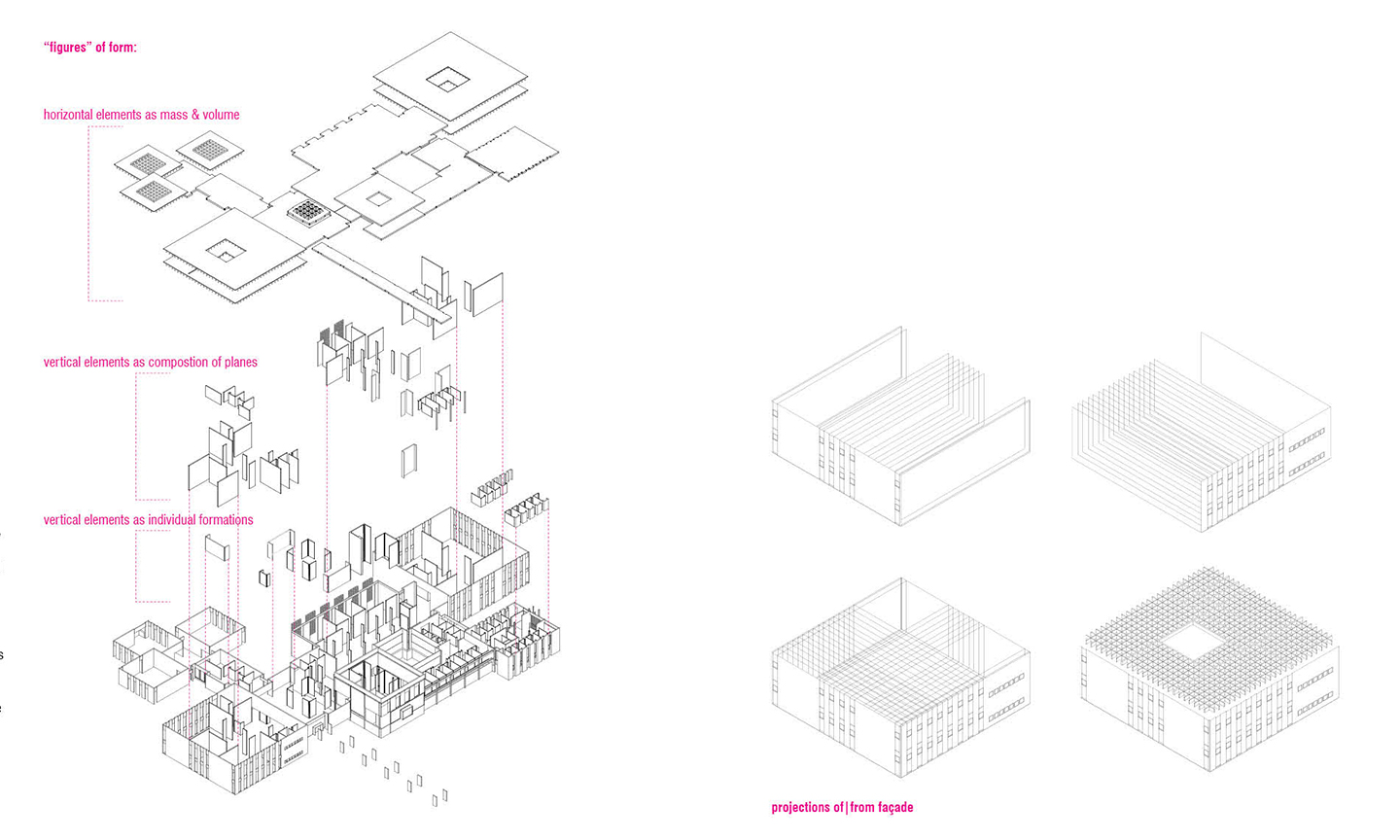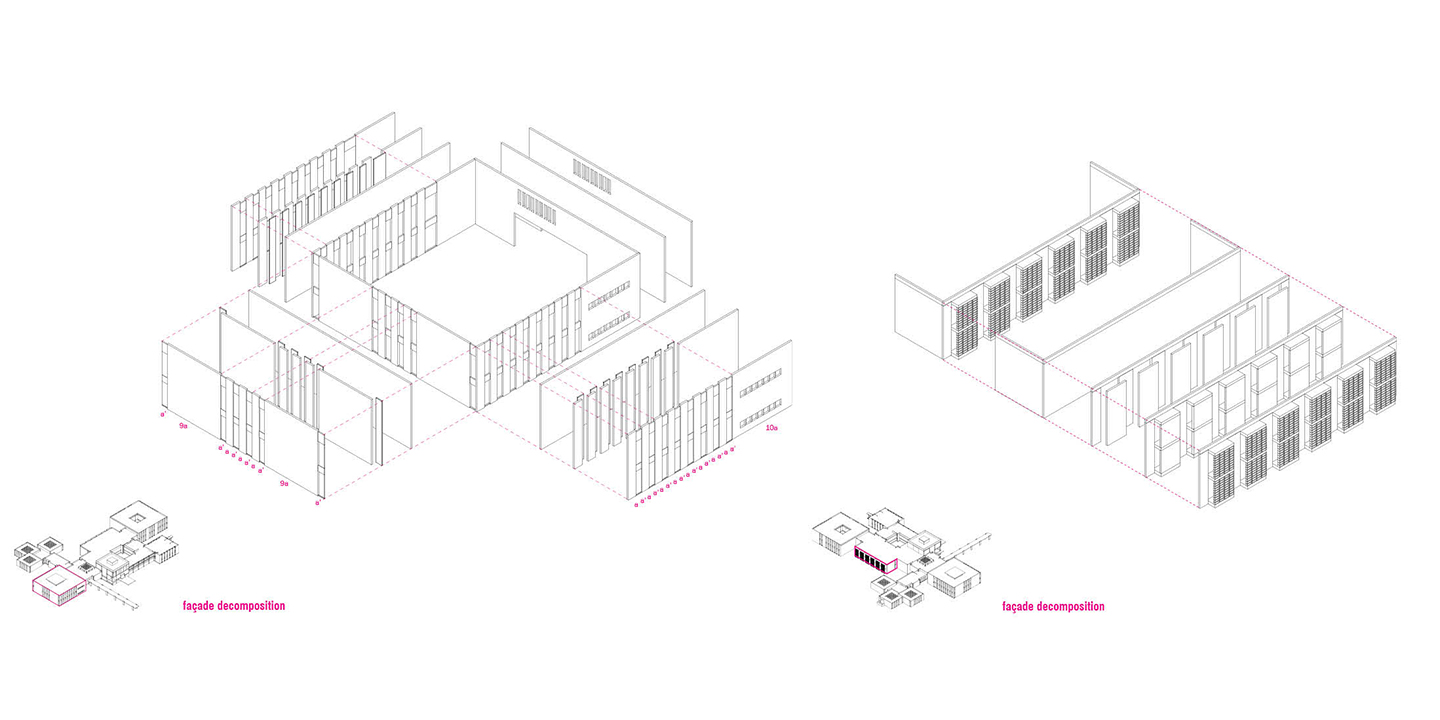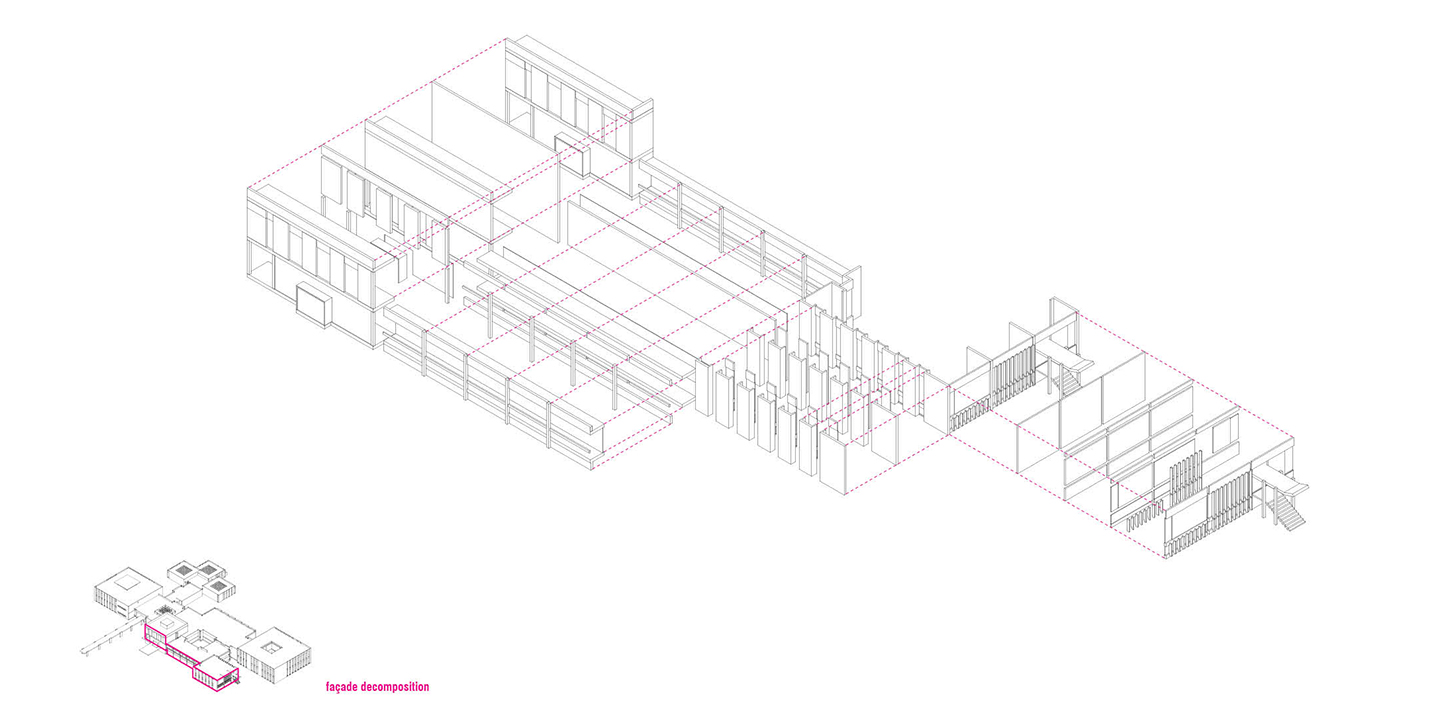Formal Analysis
Building of the Faculty of Architecture, METU | Ankara
Formal Analysis of Buildings Spring’13
Co-author: Seray Turkay
In the case of METU Faculty of Architecture, as opposed to objectifying the building, the architectural object is rather accepted, or rather read, as a volume.To understand the volume as the basis of specific form, the notion of movementis introduced. Experience of architecture is favored and a perceptual approach is obeyed to achieve a visual apprehension of the whole. Although movement can be considered as a factor that is external to the building itself, it is accepted as a geometric factor or rather a geometric entity which triggers the the intensity, size and the form of the volume with its direction(ality). Movement is assessed as the primary determinant which enables the clarity of expression and thus which gives meaning and comprehensibility to the whole organization1 in the case of Faculty of Architecture building. Movement is accepted as a property of generic form, if there is any.
Two dominant movement directions are observable within the building. One is affected and determined by the main approach to the building while the other direction can be assessed as the main movement direction within the building. Movement, accepted as the main regulator and generator of form, renders volume with the development around the line of its direction. The volumetric formation is a perceptual and a conceptual expansion. The expansion of the line of movement into volume is achieved by the introduction of the concept of “layering”. Thus, a perceptual approach is employed in the formal analysis of the building which led to an understanding of the conceptual whole. The reciprocal relationship between movement and layer(ing) is assessed as the formal basis of this critical reading. Thus, by the succession of layers through the movement, the volume is produced and experienced.
The layers perpendicular to the directionality of movement are called as “generative layers”. By passing across these layers, movement produces a perception of incremental layering and depth. Whereas, the layers parallel to the movement directionare called as “bounding layers”. These layers define and limit the volume. Volume which tends to be more homogenous and infiniteby the succession of generative layers is delimited, differentiated and fragmented by bounding layers. The generative and bounding layers are positioned respectively to two dominant movement directions. By the juxtaposition of these layers in bothmovement directions, the conceptual basis of the specific formis constructed.
The generative and bounding layers with respective movement directions act as main denominators of volumetric organization in two-dimensions. It is possible to attribute a third set of elements, which can hardly be assessed as layers yet displaya planar character, in the definition of the specific form. Whatdetermine the ultimate limits of form in the third dimension are actually the horizontal formations. Although the sizes, or limits, of the horizontal formations are comprehensible in respect to thevolumetric fragments defined by generative and bounding layers,the changes in the positionings of these horizontal formations are unstable. Freely composed level differences provide the basis for horizontal formations to gain their independent expressions as“figures” within the specific form.
The independency in formal expressions in not only valid for horizontal elements. The vertical elements which enforce the perception of generative and bounding layers also gain theirformal expressions as independent “figures”. While horizontal elements become identifiable as figures either in expressionsof “mass” or “volume”, vertical elements display themselves asfigures either as composition(s) of individual planes or indivual(s)of intact formations.
The reading of formal elements as “figures” is constant through the architectural object. Decompositions of façades into their “figures of form” and the oscillating readings of volume and façade interactions enhance the unstability within part/whole, figure/structure and plan/façade relations.
In the case of METU Faculty of Architecture, as opposed to objectifying the building, the architectural object is rather accepted, or rather read, as a volume.To understand the volume as the basis of specific form, the notion of movementis introduced. Experience of architecture is favored and a perceptual approach is obeyed to achieve a visual apprehension of the whole. Although movement can be considered as a factor that is external to the building itself, it is accepted as a geometric factor or rather a geometric entity which triggers the the intensity, size and the form of the volume with its direction(ality). Movement is assessed as the primary determinant which enables the clarity of expression and thus which gives meaning and comprehensibility to the whole organization1 in the case of Faculty of Architecture building. Movement is accepted as a property of generic form, if there is any.
Two dominant movement directions are observable within the building. One is affected and determined by the main approach to the building while the other direction can be assessed as the main movement direction within the building. Movement, accepted as the main regulator and generator of form, renders volume with the development around the line of its direction. The volumetric formation is a perceptual and a conceptual expansion. The expansion of the line of movement into volume is achieved by the introduction of the concept of “layering”. Thus, a perceptual approach is employed in the formal analysis of the building which led to an understanding of the conceptual whole. The reciprocal relationship between movement and layer(ing) is assessed as the formal basis of this critical reading. Thus, by the succession of layers through the movement, the volume is produced and experienced.
The layers perpendicular to the directionality of movement are called as “generative layers”. By passing across these layers, movement produces a perception of incremental layering and depth. Whereas, the layers parallel to the movement directionare called as “bounding layers”. These layers define and limit the volume. Volume which tends to be more homogenous and infiniteby the succession of generative layers is delimited, differentiated and fragmented by bounding layers. The generative and bounding layers are positioned respectively to two dominant movement directions. By the juxtaposition of these layers in bothmovement directions, the conceptual basis of the specific formis constructed.
The generative and bounding layers with respective movement directions act as main denominators of volumetric organization in two-dimensions. It is possible to attribute a third set of elements, which can hardly be assessed as layers yet displaya planar character, in the definition of the specific form. Whatdetermine the ultimate limits of form in the third dimension are actually the horizontal formations. Although the sizes, or limits, of the horizontal formations are comprehensible in respect to thevolumetric fragments defined by generative and bounding layers,the changes in the positionings of these horizontal formations are unstable. Freely composed level differences provide the basis for horizontal formations to gain their independent expressions as“figures” within the specific form.
The independency in formal expressions in not only valid for horizontal elements. The vertical elements which enforce the perception of generative and bounding layers also gain theirformal expressions as independent “figures”. While horizontal elements become identifiable as figures either in expressionsof “mass” or “volume”, vertical elements display themselves asfigures either as composition(s) of individual planes or indivual(s)of intact formations.
The reading of formal elements as “figures” is constant through the architectural object. Decompositions of façades into their “figures of form” and the oscillating readings of volume and façade interactions enhance the unstability within part/whole, figure/structure and plan/façade relations.





